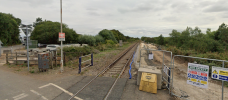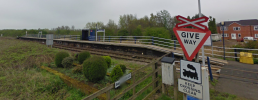Kilopylae
Member
The odds of a 1970s-style 'arms-length' organisation being created today and actually being left alone seem pretty long! - especially under a new Labour government keen to leave its mark/prove its point.
BR was at its most successful under Thatchers tenure Major screwed it all up. Tories don't want a big civil service and much prefer to outsource delivery. Main problem of course now is this will time out even if Sunak limps on till 2024 so could be second half of the decade now before any clear direction is established.The odds of a 1970s-style 'arms-length' organisation being created today and actually being left alone seem pretty long! - especially under a new Labour government keen to leave its mark/prove its point.
I thought this thread was about cost saving, not arbitrarily picking lines to be closedDo you think that the Abbey line and Thames Valley branches should be converted to busways?
I was not proposing them to be closed, I was replying to a post by A0wen. He says that the Dunstable and St Ives busways have been an improvement on the railways that they replaced (not directly, the lines had been closed some years before). I asked him if he thought that existing branch lines should be converted to busways.I thought this thread was about cost saving, not arbitrarily picking lines to be closed
TfL could take over the Abbey Line now if they wanted (traditionally it was operated as part of the North London Railways network, not the Northampton Line as it is now, to use NSE monikers). They don't want, as it's not in London. Nor are a number of the other ones.
If we wanted to Beechingise some London routes that would deliver savings and operational advantage, the following might be good suggestions:
- West Ealing to Greenford - close entirely. It is poorly used, it serves little purpose, Drayton Green station is near West Ealing, South Greenford isn't far from Perivale and there's a 3bph TfL bus service (the E11) basically covering the whole route. This is not the sort of place where a 2tph branch line will ever be well used, particularly once the Central London connection was lost. Perhaps in compensation the E11 could be increased to 4bph and the line converted to a cycleway, which would be good given the significant popularity of cycling in London.
- Chiltern innersuburban stations. Keep West Ruislip as an outer Tube interchange. Close South Ruislip (has the Central), Northolt Park (lots of buses and not far from South Harrow Picc line), Sudbury Hull Harrow (has Picc line), Sudbury and Harrow Road (near Sudbury Town LU). Keep Wembley Stadium but to be served on event days only. This would make pathing on the Chiltern route easier and may allow a bit of a recast to the slower services.
Do you think that the Abbey line and Thames Valley branches should be converted to busways?
What I don't understand about the dunstable busway, is that a single track railway has been converted into a 2 lane busway. I thought a railway formation would take up less space? A 4 track railway line is narrower that a 4 lane motorway.
Why not?No one is going to close West Ealing to Greenford.
Freight.Why not?
I believe there was a study for a possible Marylebone conversion to a bus station that had unguided buses passing inches apart?This has been discussed before - a railway line is wider than 4' 8.5" - there are clearances needed beyond that for both the rolling stock and the foundations. Road carriageways can be placed *much* closer together.
But we could close the passenger service!Freight.
Then the line isnt closed then.But we could close the passenger service!
Well if the freight operators are willing to pay the full commercial cost of keeping the line open.......Freight.
Also a busway rigidly controls the position of the vehicle so passing clearances can be tighter just need to watch buses with those mirrors that are way outside the vehicle body.This has been discussed before - a railway line is wider than 4' 8.5" - there are clearances needed beyond that for both the rolling stock and the foundations. Road carriageways can be placed *much* closer together.
Network Code would make it very difficult to close, and unless a sudden change of heart on reopening Calvert to Claydon early happens then its incredibly unlikely.Well if the freight operators are willing to pay the full commercial cost of keeping the line open.......
But I think the branch is probably far better used as a testbed for driverless trains than outright closure. It's rather well used compared to many other lines we might discuss.
I believe there was a study for a possible Marylebone conversion to a bus station that had unguided buses passing inches apart?
No one is going to close West Ealing to Greenford.
I was thinking of savings! But yes, true.Then the line isnt closed then.
Exactly how is that possible? Busways can be narrower because buses are narrower than trains, but the clearances between them aren't any closerThis has been discussed before - a railway line is wider than 4' 8.5" - there are clearances needed beyond that for both the rolling stock and the foundations. Road carriageways can be placed *much* closer together.
Exactly how is that possible? Busways can be narrower because buses are narrower than trains, but the clearances between them aren't any closer
That's not the same thing at all, you said road carriageways can be closer together. Being narrower than trains is not the same as being closer togetherThe clearances are needed beyond the width of the vehicles, so whilst a train may be on tracks which are 4' 8.5" apart and a train may be about 9' 3" wide (using a Cl 165 as an example) there then needs to be clearance beyond that for things like signalling, OHLE gantries etc, before you get to the boundary fences to keep the public out. Put it in context a regular
I can't find the previous post on this now, but I think it was @Bald Rick gave some numbers which explained it. IIRC once those factors had been accounted for a single track rail formation was pretty much the same size as a single carriageway road (i.e. a normal, road with a lane in each direction) - and because it was only single track it had less capacity than a single carriageway road, where vehicles can pass each other.
The clearances are needed beyond the width of the vehicles, so whilst a train may be on tracks which are 4' 8.5" apart and a train may be about 9' 3" wide (using a Cl 165 as an example) there then needs to be clearance beyond that for things like signalling, OHLE gantries etc, before you get to the boundary fences to keep the public out. Put it in context a regular
I can't find the previous post on this now, but I think it was @Bald Rick gave some numbers which explained it. IIRC once those factors had been accounted for a single track rail formation was pretty much the same size as a single carriageway road (i.e. a normal, road with a lane in each direction) - and because it was only single track it had less capacity than a single carriageway road, where vehicles can pass each other.
This is false, a single carriageway road to modern specification does not fit into a single track rail formation unless you want to have to have a give way gate at every bridge. Indeed it was quoted as being one reason the Cambs busway is guided, as vehicles can pass closer at speed when guided.
Trains are wider than buses, but it is only about a foot - typical train 2.8m, typical bus 2.5m.
You could use narrower buses with 2+1 seating (e.g. there is a narrow Optare Solo for tight lanes) but this adds to the cost as it is non standard.
It's possibly the case that taking an embankment to ground level or filling in a cutting would give you enough on that section, but that isn't the same as converting a whole line to a busway.
Double track can and lots have been, look for roads named e.g. Beeching Way. And many single track lines are on a double track formation.
But the Dunstable busway *was* built on a single track formation.
Yes, over bridges or tunnels are too narrow, but the width of the formation needed for a single railway line is closer to a single carriageway road than you're claiming.
A busway is not a single carriageway road. The clearances are considerably narrower than would be possible in a public road, because the buses run in a guided fashion.
I've just read in the "Railway Observer" that £1.3m has recently been spent on rebuilding Barrow Haven station which, in 2019/20, was used by 2,310 passengers or 44 a week. Could this be the last little-used station to receive such treatment?
These sorts of costs really do need to be wound in. Not just for Barrow but for all station refurbishments.
Found this on street view, dated July this year, surely a simpler cheaper solution could have been found.I've just read in the "Railway Observer" that £1.3m has recently been spent on rebuilding Barrow Haven station which, in 2019/20, was used by 2,310 passengers or 44 a week. Could this be the last little-used station to receive such treatment?


